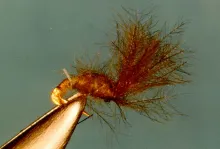#32 Pink Sabalo tied by Andrew Lamborne
Andy's notes
Hook: Mustad 577 #32
Thread: White 8/0 Unithread
Tail/wing: Clump of fine white marabou fiber tips tied in at the bend, about 1 hook length long
Hackle collar: A single pink marabou fiber wrapped (3 or 4 turns) as a hackle, with the fibers stroked back after each turn to make a nice collar
Head: 1 turn of thread to tie off marabou hackle, and a 2-turn whip finish to tie off; I wrapped the 2 turns slighly over the marabou hackle to ensure it stayed swept back in a nice collar shape
I've submitted a tarpon fly that I'll call a Pink Sabalo. It's tied like the standard Florida Keys tarpon fly (cockroach, etc.).
I chose to tie this fly because it's outlandish. I'd never actually fish with a fly tied on a #32 hook. In fact, the mere existance of such a hook seems somewhat ridiculous to me, so I decided to use it to tie a fly for an even more ridiculous task--catching a tarpon on the smallest fly possible. After I thought about it, this choice made sense for another reason. I think that the style of fly I'm imitating (tied at the rear of the hook, with the front of the shank exposed) was made (at least in part) to facilitate attaching the fly with a snell knot rather than tying a knot through the eye. Since the #32 hooks have to be tied to the tippet in the same fashion, this style of fly is appropriate.
I ran into three main problems with this fly:
First, the tail. A regular tarpon fly would have splayed feathers for the tail. I didn't have any feathers small enough for a #32 fly, so I chose to use the tips of marabou fibers instead. The size and coarseness of the marabou fibers seemed like an appropriate replacement, but I couldn't figure out a way to make them curve nicely to form the proper splayed shape. Instead, I used a clump of the fibers and tied them in a horizontal fan. The fanned shape should reasonably approximate the opening/closing movement of the tail that you get from splayed feathers on a regular tarpon pattern.
The second problem was the collar. A regular tarpon fly would have a hair collar or a hackle collar, tied at the bend. A little experimenting proved that the fine hairs I had which might have worked (like muskrat) were too tough to tie as a full collar at the bend of that tiny hook. Instead, I decided to use the marabou again, this time wound as a hackle. I got the idea when I was trying out some tiny palmered flies (bivisible and wooly bugger) for practice. Again, the size and coarseness of the marabou hackle seemed like a good match for the size of the fly, and I'm pretty happy with how it turned out.
My other main problem was the size of the thread. 8/0 Unithread is the finest that I have, and it is way out of proportion for this hook. I couldn't really solve this problem, and the result is that the fly doesn't have the nice tapered nose of a regular tarpon fly, but more of a standard head (albeit way too big for the size of the fly). I did the best I could by using a 2-turn whip finish to tie off the thread.
Tips for tiny flies
I learned that the most important thing (after picking materials to match the fly size) is to miminize the number of thread wraps used. I attached my hackle pliers to the tag end of my thread and let them hang down, rather than clipping or breaking the tag end off like I would after starting the thread on a larger fly. This allowed me to start the thread with only 1 turn, instead of using 3 or 4 turns to first lock the thread in place on the shank. I trimmed the thread tag after I had used a few more wraps for tying materials on.
Two other things that worked well for minimizing thread wraps were to use several temporary wraps to tie something on, then back off on all but one wrap before tying the next thing on, and to use material wraps instead of thread to tie other materials down. I didn't do this on the Pink Sabalo, but used it when I was trying to tie a Deceiver for practice. I tied a piece of flashabou in near the head with 3 wraps, then held marabou fibers (for the tail) in place as I wrapped the flashabou back to the bend, over the fibers. Then I wrapped the flashabou back to the tie in point, undid the last two thread wraps, wrapped the flashabou forward another turn to cover the remaining tie in wrap, and made one more turn to tie the flashabou off.
Thanks for organizing this and supplying the hooks, Hans. I can't wait to see what everyone else comes up with.
Pink Sabalo
Hook: Mustad 577 #32
Thread: White 8/0 Unithread
Tail/wing: Clump of fine white marabou fiber tips tied in at the bend, about 1 hook length long
Hackle collar: A single pink marabou fiber wrapped (3 or 4 turns) as a hackle, with the fibers stroked back after each turn to make a nice collar
Head: 1 turn of thread to tie off marabou hackle, and a 2-turn whip finish to tie off; I wrapped the 2 turns slighly over the marabou hackle to ensure it stayed swept back in a nice collar shape
Hand picked for this article
- Log in to post comments










